Adrian Collins's Blog, page 41
October 1, 2024
Celebrate ten years of Grimdark Magazine with Issue #40!
Last Updated on October 1, 2024
Ten years. Forty Issues. Grimdark Magazine has come a long, long way since being an idea I used to help a mate practice doing business consulting work way back in 2013. A whiteboard, a six pack of beer, and an afternoon stuck in a room working through templates and client engagement practices is where this ezine started. A BFSA nominated, Reddit Stabby and Aurealis award-winning publication that is the stalwart of grimdark fiction is where we now stand, ten years later.
There is no way to thank our team members past and present, our subscribers, and our readers for getting us to this point … except with a MASSIVE tenth anniversary issue. So, read on!
The coverAfter we asked Carlos Diaz to create a cover based on Scott Lynch’s first ever Gentleman Bastards short story, we had to chase him on email, phone, and messenger just to make sure he was still alive. While we all thought he’d potentially kicked the bucket with excitement, he was actually already playing with ideas and getting stuck in. Eventually, he pinged us over the below artwork for Pen Astridge to put our lovely logo on, and voila!

Honestly, take a deep breath and a seat before you read on. Maybe grab a beer, a scotch, a wine, maybe a strong tea … whatever your poison … because we have the most epic lineup of our ten year history laid out before you. This issue has everything we’re about: grimdark community favourite characters like Locke Lamora and Jorg Ancrath, massive dark and grimdark fantasy authors, indie authors, Aussie authors, an author from our open window, articles about our space, interviews with industry giants, and reviews of the most epic books coming onto the market.
Original and reprint fiction:
Little Mermaid, In Passing by Angela SlatterLock and Key by Wendy NikelUnholy Ghost by Mark LawrenceAll the Riches of Suffering by Ben GalleyThe Absolute by Aaron DriesUnder Furious Skies by Christopher BuehlmanThe Dreams of Wan Li by Andrea StewartThe Subtler Art by Cat RamboStones by Anna Smith SparkLocke Lamora and the Bottled Serpent by Scott LynchArticles, interviews, and reviews:
Grimdark, Home of the Other by Krystle MatarAn Interview with Shauna Lawless (Fiona Denton)Review: Absolution by Jeff Vandermeer (John Mauro)Project Starship: Materials Engineering Challenges in Dark Science Fiction Featuring Graham McNeill, Richard Swan, and Essa Hansen by John MauroReview: The Devils by Joe Abercrombie (Sally Berrow)An Interview with J. Michael Straczynski by Beth TablerReview: The Fury of the Gods by John Gwynne (Emma Davis)Mental Health in Fantasy and Science Fiction: A Changing Landscape by Aaron S. JonesRead Grimdark Magazine Issue #40The post Celebrate ten years of Grimdark Magazine with Issue #40! appeared first on Grimdark Magazine.
September 27, 2024
REVIEW: Deep Black by Miles Cameron
Last Updated on September 28, 2024
Miles Cameron ratchets up the space opera adventure in Deep Black, the sequel to his highly acclaimed sci-fi debut, Artifact Space, and the second volume in his Arcana Imperii series.
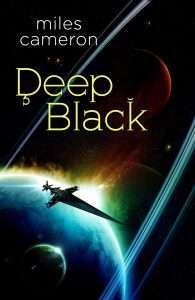 The Arcana Imperii Universe teems with trade, and the most precious commodity is xenoglas, a seemingly supernatural material that originates from an alien race known as the Starfish. Of course, the desire for xenoglas brings out the worst among some people. Technology advances but human nature remains the same, even after colonizing the greater cosmos.
The Arcana Imperii Universe teems with trade, and the most precious commodity is xenoglas, a seemingly supernatural material that originates from an alien race known as the Starfish. Of course, the desire for xenoglas brings out the worst among some people. Technology advances but human nature remains the same, even after colonizing the greater cosmos.
Miles Cameron again shines with his expertly drawn characters, who spring to life led by the spirited Marca Nbaro, an orphan who forges paperwork to become a midshipman on the Greatship Athens. I love Marca’s character growth over the course of both novels, and I especially enjoyed how the relationships with her friends develop and mature in Deep Black. There is also a romantic subplot, which I didn’t particularly appreciate in Artifact Space but found both more believable and enjoyable in Deep Black.
The worldbuilding all feels very natural in Deep Black, without any awkward info dumps. My favorite part of the Arcana Imperii Universe are the Greatships themselves, enormous sword-shaped spacecraft that are large enough to house the population of an entire city.
Deep Black delves deeper into the alien races of the Arcana Imperii Universe and the behind-the-scenes politics driving their conflicts and alliances. With its focus on both interpersonal relationships and deepening knowledge of alien races, Deep Black has strong Star Trek: The Next Generation vibes, except faster paced and a lot more fun.
My only minor quibble with Deep Black is the mystery surrounding the nature of xenoglas. Even today, all of the materials characterization tools exist to determine the composition, structure, and properties of any unknown material. It therefore seems odd that these tools weren’t applied to xenoglas, leading some characters to believe that it has almost magical properties. Anyway, this is just a slight criticism in a novel that was otherwise thoroughly enjoyable.
Overall, Deep Black delivers a highly satisfying conclusion to the current story arc while also leaving the door open for new adventures.
Read Deep Black by Miles CameronThe post REVIEW: Deep Black by Miles Cameron appeared first on Grimdark Magazine.
September 26, 2024
REVIEW: Gladiator
Released in 2000, Ridley Scott’s masterpiece is set in ancient Rome and follows a general who falls out of favour and ends up fighting in the great Colosseum as a gladiator, battling for his pride, honour, and revenge. The thrilling journey of redemption spearheaded by Russell Crowe in a star-making role as Maximus Decimus Meridius is considered one of the greatest films of all time and with a long-delayed sequel on the way, it is time to give Gladiator another watch and see its appeal for the grimdark audience.
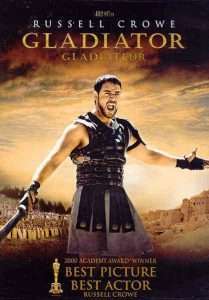 Ridley Scott opens the film setting the high standards with both a visual and auditory spectacle as with a battle against Germanic tribes and a directing masterclass with the large-scale action sequences. The direction brings you into combat and it feels raw and visceral. Russell Crowe produces a career best performance with his portrayal of the fallen warrior turned slave and eventual gladiator allowing him to showcase his range as he fights against those who have turned on him and vows revenge against Emperor Commodus (Joaquin Phoenix proving early on just how great of an actor he would be before further brilliance in films such as Joker and You Were Never Really Here). A good revenge tale with a hero with nothing more to lose is an easy sell but with great writing and a cast giving their all, Gladiator rises to levels of greatness that make it an instant classic. The writing in swords and sandals epics can sometimes be a let-down but Gladiator is a film that knows when to keep things short and sweet and when to play the epic card – “On my signal, unleash hell.” and “Brothers, what we do in life, echoes in eternity.” are two lines in the opening scene alone that made me want to get off my seat and dive into battle alongside Maximus. He is a general who you can believe inspires warriors to face their death with a smile on their faces and adds to the grounded realism and brutality of the epic story and makes you eager for him to get his revenge when he does fall. His quiet determination and unyielding resolve – “My name is Maximus Decimus Meridius. And I will have my vengeance, in this life, or the next” is incredibly powerful and works perfectly alongside Phoenix’s jealous, chilling portrayal of a man obsessed with power who is deeply insecure and a tyrannical ruler. Every scene they share is full of tension and feels as though things may explode at any given moment.
Ridley Scott opens the film setting the high standards with both a visual and auditory spectacle as with a battle against Germanic tribes and a directing masterclass with the large-scale action sequences. The direction brings you into combat and it feels raw and visceral. Russell Crowe produces a career best performance with his portrayal of the fallen warrior turned slave and eventual gladiator allowing him to showcase his range as he fights against those who have turned on him and vows revenge against Emperor Commodus (Joaquin Phoenix proving early on just how great of an actor he would be before further brilliance in films such as Joker and You Were Never Really Here). A good revenge tale with a hero with nothing more to lose is an easy sell but with great writing and a cast giving their all, Gladiator rises to levels of greatness that make it an instant classic. The writing in swords and sandals epics can sometimes be a let-down but Gladiator is a film that knows when to keep things short and sweet and when to play the epic card – “On my signal, unleash hell.” and “Brothers, what we do in life, echoes in eternity.” are two lines in the opening scene alone that made me want to get off my seat and dive into battle alongside Maximus. He is a general who you can believe inspires warriors to face their death with a smile on their faces and adds to the grounded realism and brutality of the epic story and makes you eager for him to get his revenge when he does fall. His quiet determination and unyielding resolve – “My name is Maximus Decimus Meridius. And I will have my vengeance, in this life, or the next” is incredibly powerful and works perfectly alongside Phoenix’s jealous, chilling portrayal of a man obsessed with power who is deeply insecure and a tyrannical ruler. Every scene they share is full of tension and feels as though things may explode at any given moment.
The action in Gladiator still holds to this day. Both the large-scale battles and intimate gladiatorial combat are choreographed to perfection and developed in ways to make the audience truly care about who lives and who dies. It all feels real with consequences shown for every mistake or misstep and that goes for those in the highest seat to those staring up at the world above them. Death comes for all and Gladiator is a film that truly encapsulates that. The reliance on practical effects has meant that the film has aged well and it will be interested to compare the sequel when it arrives. The story is full of political intrigue and the tale of revenge is timeless, driven by the great performance of Crowe and masterful direction of Scott. The tale of a weary Maximus driven by revenge even reminded me of great recent literary grimdark warriors such as Logen Ninefingers and Monza Murcatto from Joe Abercrombie’s First Law world and had me salivating at the potential for such tales to arrive on screens with the right people involved.
Gladiator is a timeless classic. This film is truly one that echoes throughout eternity and is one of the greatest action films ever made with a cast full of career-best efforts and a story that has inspired the direction and action of many since (Game of Thrones, Those About to Die, Spartacus to name a few). With a sequel on the way, now is the time to give the Maximus Decimus Meridius another watch – press play, and unleash hell!
The post REVIEW: Gladiator appeared first on Grimdark Magazine.
September 25, 2024
REVIEW: Necrology by Meg Ripley
Necrology by Meg Ripley is a debut dark fantasy novel about the fantastical alternate history of the Salem Witch trials. Set in the 1800s – two hundred years after the events in Salem – Magical women called the Dirty have sworn off their innate magic (Dirt) in exchange for peace from non-magical men called the Freemen. But peace is never an option where a man’s power is threatened. Necrology explores a gloomy world built on petrifyingly deep-rooted male supremacy.
 Necrology is the first book in the Dirty duology, following an 8-year-old orphan girl named Rabbit as she navigates a harsh new reality after her world is shattered. When the matron of her orphanage, Whitetail, is arrested and sentenced to death for the murder of her ward and her suitor ‘Beard’ who is also the Supreme Leader’s heir, Rabbit is abruptly taken to his home. There, she is groomed to become his ‘star witness’ under the pretense of saving her family and innocents from an impending war. Here, we see glimpses of Salem’s dark history repeating itself – false confessions with the promise of redemption, and women ripped and isolated from their communities.
Necrology is the first book in the Dirty duology, following an 8-year-old orphan girl named Rabbit as she navigates a harsh new reality after her world is shattered. When the matron of her orphanage, Whitetail, is arrested and sentenced to death for the murder of her ward and her suitor ‘Beard’ who is also the Supreme Leader’s heir, Rabbit is abruptly taken to his home. There, she is groomed to become his ‘star witness’ under the pretense of saving her family and innocents from an impending war. Here, we see glimpses of Salem’s dark history repeating itself – false confessions with the promise of redemption, and women ripped and isolated from their communities.
Ripley’s narrative deftly explores Rabbit’s struggle for identity amidst chaos, as she grapples with the truth about her circumstances and the motives of those around her. As her understanding of goodness is challenged, readers are drawn into a dark, thought-provoking exploration of morality and survival. Rabbit is a resilient character, and her determination to do what’s right puts her in a moral dilemma. Should she lie to get what she wants? Or simply tell the truth and leave being good up to the people with power?
I thoroughly enjoyed the character of Whitetail, a majestic and stoic witch descended from Mad Dog—the original Dirty Woman who signed the pact with the Freemen two centuries ago. Standing over six feet tall and flaunting antlers due to a rebounding curse, she embodies both power and tragedy. What truly captivated me, though, was her chilling decision to swallow her twin sister to safeguard the secrets of the murdered held in the Necrology (a rock), that could ignite a war. Her pregnant belly is a sickeningly good twist that adds layers to her character and raises the stakes in the story.
I found the use of the word “Dirty” in reference to witches and “Dirt” in reference to magic incredibly witty. Ripley doesn’t shy away from depicting the contempt the Freemen have for women in general—not just witches. However, I should caution that the writing style may not appeal to everyone; it often reads like a screenplay, complete with detailed character directions. That said, I would be first in line if Necrology were ever adapted into a film. I desperately want to see Whitetail brought to life on screen!
Overall, Necrology has brought the war on witches to a darker level, and I cannot wait for the release of the second book, Woodfeast. If you are a fan of the madness that was the Salem Witch Trials, The Crucible and Weyward, you are going to love this imaginative retelling that even Reverend Parris would approve of.
Read Necrology by Meg RipleyThe post REVIEW: Necrology by Meg Ripley appeared first on Grimdark Magazine.
September 24, 2024
REVIEW: The Boodless Princes by Charlotte Bond
The Bloodless Princes feels like a very different novella compared to to The Fireborne Blade, with a move away from the focus on dragons and their magic and towards the magic of human mages and the battle between the two lords of the underworld (the gravelands).
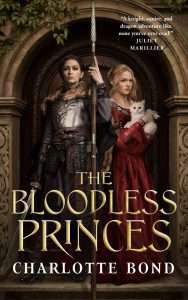 The mage Hosh attempts to swap his place in the gravelands with Saralene by taking over her body. In a desperate bid to save her partner, Saralene’s champion knight, Sir Maddileh, finds a very unlikely ally–one who was assumed to be dead. Together they must venture to the gravelands to request the aid of one of the Bloodless Princes, the rulers of the gravelands with one controlling the day and the other the night.
The mage Hosh attempts to swap his place in the gravelands with Saralene by taking over her body. In a desperate bid to save her partner, Saralene’s champion knight, Sir Maddileh, finds a very unlikely ally–one who was assumed to be dead. Together they must venture to the gravelands to request the aid of one of the Bloodless Princes, the rulers of the gravelands with one controlling the day and the other the night.
Bond continues to showcase the more experimental allowances that I feel come with writing shorter form fiction. The Bloodless Princes could almost be a stand alone novella, the feel of it is so different to The Fireborne Blade, and I think that’s a good thing. The same familiar bones of the world are there, but this read is a very different (and still great) experience to its predecessor, and I think those differences and new ideas and concepts are so easy to take on because she has such mastery of story construction in under 40,000 words.
Once again, I really enjoyed Bond’s use of book chapters from the in-world mages’ non-fiction library to provide extra context and detail. This time Bond uses a dragon history juxtaposed against a human history to showcase two sides of the same coin.
Compared to The Fireborne Blade, this felt less dark and a little more focussed on the burgeoning love between Maddileh and Saralene. That’s not really where my areas of interest in reading lay, so I didn’t enjoy that aspect of the story so much, when I consider it against what I loved about The Fireborne Blade.
What I did massively enjoy was the character of Mienylyth and the perspective provided on the dragons. I also like Bond’s depiction of the two underworlds, and her playing with the mythology versus the fantastical reality. These two aspects alone made it worth the short time investment to read The Bloodless Princes.
While the shift in feel and themes probably wasn’t my favourite thing ever, this is why I love novellas so much. Authors have the freedom to experiment more with less risk to a reader should it not work out for their reading experience. The Bloodless Princes delivers more of the wonderful fantasy duo of Sir Maddileh and Saralene, and I’m hoping to read more about them the years to come.
Read The Boodless Princes by Charlotte BondThe post REVIEW: The Boodless Princes by Charlotte Bond appeared first on Grimdark Magazine.
September 23, 2024
REVIEW: The Book of Witches ed. by Jonathan Strahan
Depending on your tastes, the spooky season is in full swing or about to descend. Either way, if seasonal reading is your thing, it is the best time of the year to pick up The Book of Witches. The latest spellbinding anthology to be edited by Jonathan Strahan, The Book of Witches, has just under 30 short story and poetry contributions from a host of speculative fiction writers. Each piece also has its own illustration from Hugo-nominated artist Alyssa Winans, which was an additional touch that I really enjoyed in this collection.
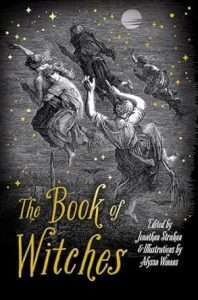 Not every tale in The Book of Witches will appeal to the Grimdark Magazine crowd; it is a very varied anthology in terms of writing style. Although each story has fantastical elements and at least one witch, they range from dark and disturbing to funny and folksy. Overall, it was an excellent read for this time of year. Some of these authors were new to me, but many were ones I had already read or had been recommended to me by fellow members of team GdM, such as P. Djèlí Clark, Cassandra Khaw, Premee Mohamed, Angela Slatter, Andrea Stewart, C. L. Clark, and Fonda Lee.
Not every tale in The Book of Witches will appeal to the Grimdark Magazine crowd; it is a very varied anthology in terms of writing style. Although each story has fantastical elements and at least one witch, they range from dark and disturbing to funny and folksy. Overall, it was an excellent read for this time of year. Some of these authors were new to me, but many were ones I had already read or had been recommended to me by fellow members of team GdM, such as P. Djèlí Clark, Cassandra Khaw, Premee Mohamed, Angela Slatter, Andrea Stewart, C. L. Clark, and Fonda Lee.
In this review, I will not touch on all the stories in The Book of Witches, but I will highlight my personal favourite, which was Cassandra Khaw’s “Met Swallow.” It was the eighth entry in the collection, and by this point, I had given up trying to guess what each story would be about. Khaw has been an author on my radar for years since John Mauro described her The Salt Grows Heavy as a “darkly beautiful nightmare brought to life,” and every team member who has reviewed her work has had good things to say about it. I am just a bit of a scaredy cat; frankly, I find the covers terrifying.
“Met Swallow” was not as frightening as I thought a Khaw short story would be. It was not even the most unnerving story in the whole collection. But I was thoroughly impressed with how Khaw crafted a narrative that spanned years into only fifteen pages and still evoked an emotional response about Amaranth’s life and death. Khaw touched on love, life, family, and all that might mean, and finally ended “Met Swallow” in a way that was quite gruesome but also made me laugh out loud with the last line. Which is sometimes exactly what you want from a bed time story!
I only loved some stories in The Book of Witches. However, with such a varied collection, not all are expected to hit the sweet spot for me. I would say, though, that I enjoyed the vast majority of them. They are all well-written and good examples of short fiction. I found The Book of Witches a literary equivalent of liquorice all sorts. I like them enough to buy a pack, but while snacking, some are better than others, and some I only eat because they are there. One personal gripe I had is that I found the text in the paperback small. It’s not often that I need to search for reading glasses, but I did with this, and it was a slight annoyance. So, this might be worth noting if you consider picking up a physical copy of The Book of Witches.
I enjoyed being able to sample such a range of authors and I have found some new names to keep an eye out for. Also, I really enjoy short fiction and feeling like I have finished something without it taking me an age to read. I got that sense of satisfaction with this book, as even the longer pieces can be read in around half an hour. For my vote, The Book of Witches is worth the reading time and is a perfect choice for a witchy read. After all, as the dedication says, “There’s a little witch in all of us.’ Thank you to the team at Harper Voyager for sending us a review copy.
Read The Book of Witches ed. by Jonathan StrahanThe post REVIEW: The Book of Witches ed. by Jonathan Strahan appeared first on Grimdark Magazine.
September 22, 2024
REVIEW: Joker
Comic book movies are still all the rage and it takes something special to stand out. Releasing a dark villain-driven movie based on a character who has already had many appearances in film (and the range in quality from the brilliant Oscar-winning Heath Ledger in The Dark Knight to Jared Leto’s mess in The Suicide Squad) is a bit of a risk but Todd Phillips certainly wasn’t going to play it safe with Joker. Casting Joaquin Phoenix in the titular role, Phillips double down on the risk by creating a movie that dared to ask how low does the support in a society have to go to create a villain as despicable as Joker? And to do it with barely a nod to Batman, that’s a director with guts and the bold move certainly pays off.
 Joker is its own film its own world. There are no links to other characters and movies and its refreshing to see a comic book movie without a hundred links to others. Whilst it is its own film, many in the audience will be aware of the character due to his popularity over the years as Batman’s greatest villain and there are little nods to the character’s history and great pieces of work over the years. Joker takes a grounded approach when bringing its world to life, even more so than Matt Reeves’ brilliant The Batman. It revels in the films and stories that have inspired it such as Martin Scorsese’s Taxi Driver. They both tell stories of lonely men struggling with mental illness and not getting the support they need and the consequences of this. In Joker, Arthur Fleck is man down on his luck. Working as a clown-for-hire in Gotham City in 1981, he ends up losing his job and being beat up by thieves. Gotham is suffering from high rates of unemployment, crime, and poverty. Arthur has sessions with his social worker to get his medication and deal with his ongoing mental health issues but even that support is being cut. He also battles with a condition that leads to him laughing, often hysterically, at sometimes inappropriate times. The little bits of light in his life are the moments where he looks after his ill mother who enjoys watching a show hosted by Murray Franklin (Robert DeNiro) and Arthur begins to develop a fantasy where he appears on the show with Murray and speaks about how he cares for his mother, who used to work for Thomas Wayne. With his issues building, dressed as a clown, he shoots dead two people on the subway who were threatening him. This act leads to the tension in the city boiling over as some see Fleck as a hero standing up for himself and those who are looked down on.
Joker is its own film its own world. There are no links to other characters and movies and its refreshing to see a comic book movie without a hundred links to others. Whilst it is its own film, many in the audience will be aware of the character due to his popularity over the years as Batman’s greatest villain and there are little nods to the character’s history and great pieces of work over the years. Joker takes a grounded approach when bringing its world to life, even more so than Matt Reeves’ brilliant The Batman. It revels in the films and stories that have inspired it such as Martin Scorsese’s Taxi Driver. They both tell stories of lonely men struggling with mental illness and not getting the support they need and the consequences of this. In Joker, Arthur Fleck is man down on his luck. Working as a clown-for-hire in Gotham City in 1981, he ends up losing his job and being beat up by thieves. Gotham is suffering from high rates of unemployment, crime, and poverty. Arthur has sessions with his social worker to get his medication and deal with his ongoing mental health issues but even that support is being cut. He also battles with a condition that leads to him laughing, often hysterically, at sometimes inappropriate times. The little bits of light in his life are the moments where he looks after his ill mother who enjoys watching a show hosted by Murray Franklin (Robert DeNiro) and Arthur begins to develop a fantasy where he appears on the show with Murray and speaks about how he cares for his mother, who used to work for Thomas Wayne. With his issues building, dressed as a clown, he shoots dead two people on the subway who were threatening him. This act leads to the tension in the city boiling over as some see Fleck as a hero standing up for himself and those who are looked down on.
Joker is not an easy movie at all. It is a hard watch with difficult themes and scenes that shine a light on issues that are still being seen in the world today. Phoenix is superb in his role as the tortured titular star who is beaten to the point of breaking and turning on the world. Great villains are ones that you can understand even if their actions may terrify you and the villain’s journey here is done to perfection. Phoenix displays to vulnerability of Fleck with every small detail, every twitch in his smile, every uncomfortable laugh and Phillips does brilliantly to keep the camera centred on the star – often when others may have cut away. It is a film designed to make you uncomfortable for a reason and in doing so, Phillips and Phoenix created a work of art that is incredibly fresh in a genre that is oversaturated easy stories and issues. The cinematography, sound, and editing are all expertly crafted to deliver a film that isn’t intended to make you smile but is instead there to make you feel and question the world around you. It is a work of art in a way that not many comic book blockbusters are and it stands out all the more for it right up to its explosive ending.
Joker may not be a film you will want to watch over and over but it is one that will stay with you forever. Masterfully crafted with Phoenix delivering the best performance of his stellar career, Joker is comic book film like no other. Whilst its brilliance can stand on its own away from others, there is a sequel on the way and it has a lot to live up to!
The post REVIEW: Joker appeared first on Grimdark Magazine.
September 21, 2024
REVIEW: Beetlejuice Beetlejuice
The Juice is loose. Tim Burton returns to the world of his 1988 fan favourite Beetlejuice with Beetlejuice Beetlejuice. I admit that I am not old enough to have seen Beetlejuice on the big screen, but it is a film I love and have watched many times since my teens. I was so excited to get the chance to see the sequel at the cinema, and I think that Beetlejuice Beetlejuice is everything a fan could want from the return of our favourite tricksy demon. It’s an excellent watch for the spooky season if you still wish for some dark humour and horror without having to hide behind your hands.
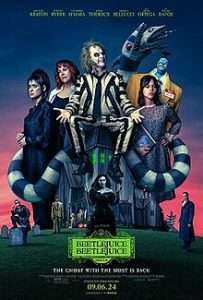 Burton managed to get many of the original cast to reprise their roles in Beetlejuice Beetlejuice, with Michael Keaton returning as the titular Beetlejuice, Winona Ryder as Lydia Deetz, and Catherine O’Hara as Delia. Their return makes the film feel awesomely familiar and adds to my nostalgia while watching. So did Danny Elfman’s fantastic musical score; for me Elfman’s scores are a quintessential part of a Burton film.
Burton managed to get many of the original cast to reprise their roles in Beetlejuice Beetlejuice, with Michael Keaton returning as the titular Beetlejuice, Winona Ryder as Lydia Deetz, and Catherine O’Hara as Delia. Their return makes the film feel awesomely familiar and adds to my nostalgia while watching. So did Danny Elfman’s fantastic musical score; for me Elfman’s scores are a quintessential part of a Burton film.
The newcomers to the series are a fabulous part of the cast ensemble, with Jenna Ortega playing Astrid, Lydia’s teenage daughter, and Justin Theroux as Lydia’s alarming orange smarmy boyfriend, Rory. Although Ortega fits perfectly visually as Ryder’s fictional daughter, her performance as a sullen eyeliner-wearing teen does not quite match up to that of Ryder’s Lydia in the original. My favourite of the new cast is a hilarious Willem Dafoe as Wolf Jackson, a deceased actor, now dead crime detective. His scenes stand out to me as some of the funniest of the whole film.
The reason the Deetz family returns to our screen is triggered by tragedy. The death of patriarch Charles Deetz (shown through some amusing stop-motion clay animation, no less) means the Deetzs must return to Winter River for the funeral and to clear out the family home, still known locally as the ‘ghost house.’ Lydia has to leave her Ghost Hunting show, Delia cancels her latest art show, and Astrid is taken out of school. Rory is along for the ride, but no one seems to want him around. Demonic capers ensue with Beetlejuice using Lydia’s proximity to a scale model of Winter Ridge to try and win her back, and Astrid finds herself mixed up with supernatural shenanigans.
I accept that Beetlejuice Beetlejuice will not be for everyone. Some will maintain that nothing can compare to the original, or some will find it silly slapstick. Both statements are true to a degree. I would say that the original is still the better film, and although the sequel tries hard to match the original for dark humour and general gothic weirdness, it does not quite manage. It is also endearingly silly in place. If you are after a work of high-brow cinema, this will not be for you. But this is a fun, darkly comedic film that goes in the same vein as the original. Keaton is fantastic as Beetlejuice, and I am so glad Burton said he would not do a sequel without him because no one else could capture the manic energy of Beetlejuice the same way that Keaton does. The special effects are delightfully traditional, making the film visually very similar to the original. There are also many throwbacks to the first film, which, as a fan, I enjoyed spotting while watching.
I am a fan of spooky (but not scary) films, so Beetlejuice Beetlejuice was worth watching. Based on the enjoyment I got out of it; it was even worth the cost of seeing it at the cinema and the overpriced popcorn. If you liked the first film or want to make your weird little self happy for a couple of hours, you should go and give this a chance.
The post REVIEW: Beetlejuice Beetlejuice appeared first on Grimdark Magazine.
September 20, 2024
REVIEW: A Song to Drown Rivers by Ann Liang
In her adult debut, Ann Liang tries her hand at historical fiction with A Song to Drown Rivers. We follow Xishi, based off of one of the Famous Four Beauties of Ancient China with the same name, who lives a humble life with her parents in the war-torn kingdom of Yue, after the death of her sister at the hands of enemy soldiers. Xishi’s beauty is coveted amongst her village, and she is steadily on the path that all beautiful women are expected to find themselves down: marrying well and supporting their families. When Fanli, a military advisor to the King, offers Xishi the opportunity to wield her beauty as a weapon against the enemy kingdom of Wu, Xishi finds herself straying from the path initially paved for her. She is to infiltrate the enemy palace under the guise of a concubine, offered as a gift to the young King of Wu, and topple the royal decree from within. In preparation for her mission, she finds herself falling for Fanli, and he for her. With her heart and her kingdom on the line, Xishi must gain the affection and trust of the King, without losing herself in the process.
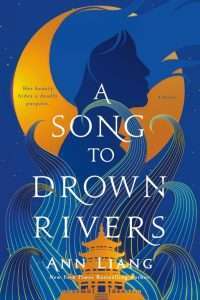 A Song to Drown Rivers is a standalone historical epic, erring on the side of YA, but ultimately classified as adult, perhaps due to the few moments of visceral violence that war entails. The grimdark value is found within scenes like these, but also within the thread of the story that holds Xishi as a weapon and a pawn within a much larger political game. Whilst the romance felt like a steady string holding the story taut, it is the war, and Xishi’s role within it, that really had me turning the pages. Had the novel been longer, with more action in the Wu court, I would have felt compelled to agree with the classification of this story as an ‘epic’, but it ultimately fell short for me, as the story felt stunted and rushed. As mentioned, the story felt slightly YA, despite its categorisation as adult. Many of the plot points felt juvenile and convenient. The Wu court was supposed to be a hotbed for deception and corruption, but ultimately Xishi had to deal with a few aggressions from other concubines. The parts of the novel that did feel darker, such as the scenes where court advisors attempts to intercept Xishi’s influence over King Fuchai, were exceptionally done, and my only critique is that I wish there were more scenes of this manner. The political intrigue throughout was thrilling, and I enjoyed how Xishi slot herself into areas that were simply not welcoming to women.
A Song to Drown Rivers is a standalone historical epic, erring on the side of YA, but ultimately classified as adult, perhaps due to the few moments of visceral violence that war entails. The grimdark value is found within scenes like these, but also within the thread of the story that holds Xishi as a weapon and a pawn within a much larger political game. Whilst the romance felt like a steady string holding the story taut, it is the war, and Xishi’s role within it, that really had me turning the pages. Had the novel been longer, with more action in the Wu court, I would have felt compelled to agree with the classification of this story as an ‘epic’, but it ultimately fell short for me, as the story felt stunted and rushed. As mentioned, the story felt slightly YA, despite its categorisation as adult. Many of the plot points felt juvenile and convenient. The Wu court was supposed to be a hotbed for deception and corruption, but ultimately Xishi had to deal with a few aggressions from other concubines. The parts of the novel that did feel darker, such as the scenes where court advisors attempts to intercept Xishi’s influence over King Fuchai, were exceptionally done, and my only critique is that I wish there were more scenes of this manner. The political intrigue throughout was thrilling, and I enjoyed how Xishi slot herself into areas that were simply not welcoming to women.
Xishi is a strong character, one whose growth felt natural with the situation she finds herself in. Every political move she made felt realistic to her character, which gave the story a sense of self-awareness that a lot of other ‘chosen one’ stories may lack. I particularly enjoyed the character of Fuchai, King of Wu. He is multi-faceted; beautiful to all, kind to Xishi, barbaric to anyone who slightly crosses him. It was fascinating reading the dynamics between him and Xishi, as her façade takes her deeper into the Wu court, and she is subject to his great affection, and greater disdain from his advisors. I also enjoyed the social commentary running throughout the novel, which questions whether Kings are the pillars of power that they are assumed to be, especially with all that Xishi has been able to achieve with simply her beauty as the means. Fanli is a perfectly mediocre love interest and character, although he never felt naturally aligned with the story. He always felt like an accessory in addition to Xishi, rather than a prominent player within the game. I would have enjoyed more development in his character, and a deeper involvement in the second half of the novel, as he felt quite one dimensional throughout.
Liang’s historical debut is an exploration of womanhood, beauty, war and love against all odds. She weaves a tapestry of tragedy and hope into an existing lore, and with it questions who power should truly lie with, and what they would do to attain it wholly.
Read A Song to Drown Rivers by Ann LiangThe post REVIEW: A Song to Drown Rivers by Ann Liang appeared first on Grimdark Magazine.
September 19, 2024
REVIEW: Those About to Die
With a big-time director and screenwriter like Roland Emmerich (Independence Day, Godzilla, Stargate) and mega-stars like Anthony Hopkins (Silence of the Lambs, Thor) and Iwan Rheon (Game of Thrones, Misfits) attached, Those About to Die was billed as Game of Thrones with togas and had an audience waiting to be thrilled. Set during a period of political intrigue in the Roman Empire, could the expensive TV series live up to its own hype?
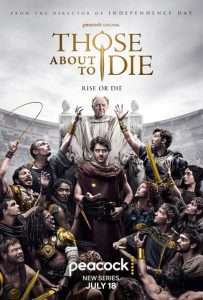 The Romans have given writers ample inspiration to create thrilling stories and interesting characters over the years. We don’t have too long to wait before a sequel to one of the greatest movies ever made, Gladiator, hits the big screen but to fill the gap before then, we have Those About to Die. Rome in the first Century CE is like a viper’s den. Emperor Vespasian (an under-used Hopkins) has a choice to make as he decides which of his sons deserves to take over from him – his well-respected soldier son Titus, or the wily politician, Domitian. Hopkins in the Emperor role deciding between the two sons was a bit too similar to his role as Odin in the MCU, torn between his two very different sons, one who values guile and intelligence whilst the other favours brute strength but Hopkins does well enough in the role and the masterful actor can carry a scene without even pushing himself. Meanwhile, a group of young Andalucians arrive in the city as horsemen at the height of popularity of chariot racing and a determined Numidian mother fights to save her family from slavery and death. Finally, we have Tenax (Iwan Rheon), a bookmaker from the streets with dreams of rising to the upper echelons of the great city like Rome’s version of Thomas Shelby in Peaky Blinders. There’s a lot going on and the comparisons to Game of Thrones aren’t earned with some paper-thin storytelling and wooden acting in the early episodes which thankfully improves as the series goes on and the cast seem to get comfortable in their roles. It takes a few episodes to care about the plights of the main cast but patience is rewarded, even if it doesn’t hit the heights of recent TV greats and nowhere near Gladiator.
The Romans have given writers ample inspiration to create thrilling stories and interesting characters over the years. We don’t have too long to wait before a sequel to one of the greatest movies ever made, Gladiator, hits the big screen but to fill the gap before then, we have Those About to Die. Rome in the first Century CE is like a viper’s den. Emperor Vespasian (an under-used Hopkins) has a choice to make as he decides which of his sons deserves to take over from him – his well-respected soldier son Titus, or the wily politician, Domitian. Hopkins in the Emperor role deciding between the two sons was a bit too similar to his role as Odin in the MCU, torn between his two very different sons, one who values guile and intelligence whilst the other favours brute strength but Hopkins does well enough in the role and the masterful actor can carry a scene without even pushing himself. Meanwhile, a group of young Andalucians arrive in the city as horsemen at the height of popularity of chariot racing and a determined Numidian mother fights to save her family from slavery and death. Finally, we have Tenax (Iwan Rheon), a bookmaker from the streets with dreams of rising to the upper echelons of the great city like Rome’s version of Thomas Shelby in Peaky Blinders. There’s a lot going on and the comparisons to Game of Thrones aren’t earned with some paper-thin storytelling and wooden acting in the early episodes which thankfully improves as the series goes on and the cast seem to get comfortable in their roles. It takes a few episodes to care about the plights of the main cast but patience is rewarded, even if it doesn’t hit the heights of recent TV greats and nowhere near Gladiator.
The political intrigue stands up quite well in Those About to Die, as it should in such a fertile setting. Grimdark fans will lap up the backstabbing and treachery in the show and the glimmers of light and hope stop the series from falling into all out despair at times with some gruesome deaths weighing heavy on the show at crucial moments. It certainly is a show that is not afraid to show the darkness of the Roman Empire. The chariot races and arena fights are exciting and interesting even if the CGI at times gives the show a bit of a cheap feel. The many storylines don’t feel fully developed for much of the season but there are moments where the beats hit hard and Tenax’s backstory and his care for children fleshes him out more than others whilst determined mother Cala has some of the best dialogue as she does whatever she can to rise up in Rome to defend her children and save them from the horrors of the city. The balance between street level Rome and the battle for the title of Emperor is woven together well but perhaps at the expense of either truly shining through as excellent storytelling. Still, Those About to Die does eventually grow into a fun and exciting series to fill that Roman void before Gladiator 2 is here.
A slow but eventually interesting series full of twists and turns in the city of Rome. Those About to Die may not get a solid thumbs up from the Emperor but it fights until the end and goes down in bloody glory. A fun, if nowhere near perfect romp during one of the greatest periods in history – worth a watch and perhaps season 2 will be when it hits its stride.
Watch the Trailer for Those About to DieThe post REVIEW: Those About to Die appeared first on Grimdark Magazine.



